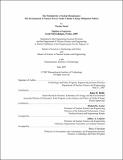| dc.contributor.advisor | John M. Reilly. | en_US |
| dc.contributor.author | Osouf, Nicolas | en_US |
| dc.contributor.other | Massachusetts Institute of Technology. Dept. of Nuclear Science and Engineering. | en_US |
| dc.date.accessioned | 2008-02-27T20:36:12Z | |
| dc.date.available | 2008-02-27T20:36:12Z | |
| dc.date.copyright | 2007 | en_US |
| dc.date.issued | 2007 | en_US |
| dc.identifier.uri | http://hdl.handle.net/1721.1/40298 | |
| dc.description | Thesis (S.M.)--Massachusetts Institute of Technology, Engineering Systems Division, Technology and Policy Program; and, (S.M.)--Massachusetts Institute of Technology, Dept. of Nuclear Science and Engineering, 2007. | en_US |
| dc.description | This electronic version was submitted by the student author. The certified thesis is available in the Institute Archives and Special Collections. | en_US |
| dc.description | Includes bibliographical references (p. 113-115). | en_US |
| dc.description.abstract | Anthropogenic emissions of greenhouse gases are very likely to have already changed the Earth's climate, and will continue to change it for centuries if no action is taken. Nuclear power, a nearly carbon-free source of electricity, could contribute significantly to climate change mitigation by replacing conventional fossil-fueled electricity generation technologies. To examine the potential role of nuclear power, an advanced nuclear technology representing Generation III reactors is introduced into the Emissions Predictions and Policy Analysis economic model, which projects greenhouse gas and other air pollutant emissions as well as climate policy costs. The model is then used to study how the cost and availability of nuclear power affect the economy and the environment at the global scale. A literature review shows that estimates of nuclear power costs vary widely, because of differences in both calculation methods and cost parameters. Based on a sensitivity analysis, the most important parameters are the discount rate, the overnight cost, the capacity factor and the economic lifetime. The methodological differences affect not only the absolute power costs, but also the relative costs among electricity generation technologies. | en_US |
| dc.description.abstract | (cont.) Acknowledging this uncertainty, a levelized cost model leads to bus-bar cost scenarios ranging from $35/MWh to $60/MWh. Cap-and-trade climate policies strengthen the development of nuclear power in the high nuclear cost scenarios. In low-cost cases, nuclear power grows significantly even without climate policies, which have little further influence on the market share of nuclear power. Lower costs of nuclear power decrease the costs of climate policies: the consumption NPV loss due to a 550ppm climate policy is reduced by 36% if nuclear costs are reduced from the highest to the lowest scenario. Nuclear power development at the largest scale projected would involve the depletion of currently known conventional and phosphate uranium deposits. Environmental benefits of the development of competitive nuclear power include a reduction in greenhouse gas emissions, even if no climate policy is implemented. For example, CO2 emissions decrease by 32% in 2050 in the lowest nuclear cost scenario. Conventional pollutant emissions are also reduced: NOx and SO2 emissions decrease by 14% and 24% in 2050. | en_US |
| dc.description.abstract | (cont.) The economic value of the political decision to keep the nuclear option open is evaluated to range between $1,300 billion and $17,600 billion, in terms of consumption NPV loss, depending on the climate policy regime. These benefits should eventually be weighed against the proliferation, waste and safety issues associated with further development of nuclear power. | en_US |
| dc.description.statementofresponsibility | by Nicolas Osouf. | en_US |
| dc.format.extent | 115 p. | en_US |
| dc.language.iso | eng | en_US |
| dc.publisher | Massachusetts Institute of Technology | en_US |
| dc.rights | M.I.T. theses are protected by copyright. They may be viewed from this source for any purpose, but reproduction or distribution in any format is prohibited without written permission. See provided URL for inquiries about permission. | en_US |
| dc.rights.uri | http://dspace.mit.edu/handle/1721.1/7582 | |
| dc.subject | Technology and Policy Program. | en_US |
| dc.subject | Nuclear Science and Engineering. | en_US |
| dc.title | The potential for a nuclear renaissance : the development of nuclear power under climate change mitigation policies | en_US |
| dc.type | Thesis | en_US |
| dc.description.degree | S.M. | en_US |
| dc.contributor.department | Massachusetts Institute of Technology. Department of Nuclear Science and Engineering | |
| dc.contributor.department | Massachusetts Institute of Technology. Engineering Systems Division | |
| dc.contributor.department | Technology and Policy Program | |
| dc.identifier.oclc | 191063916 | en_US |
